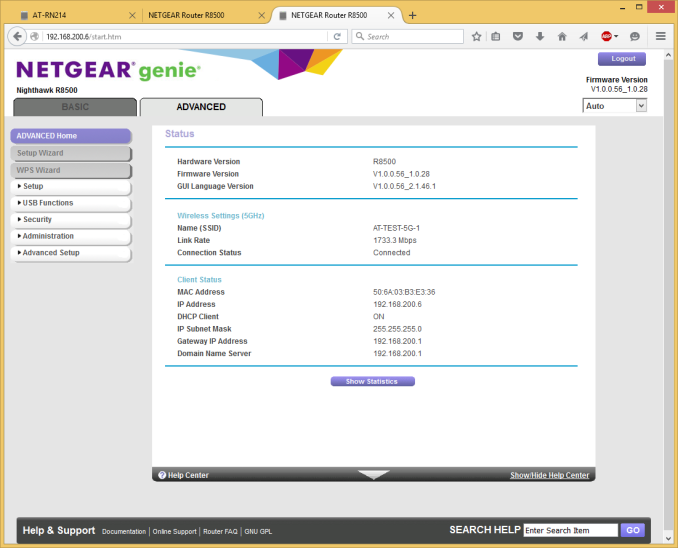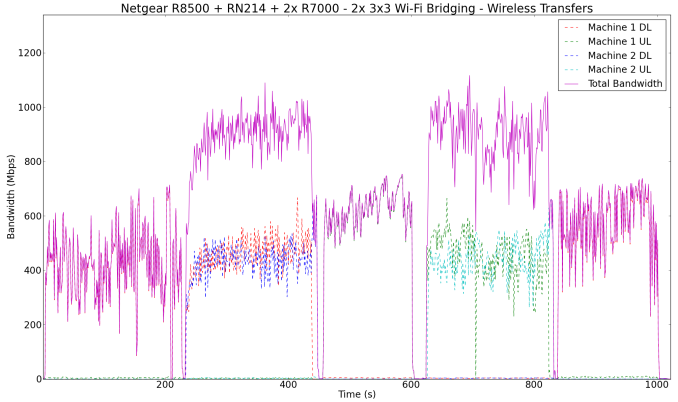Netgear Nighthawk X8 R8500 AC5300 Router Brings Link Aggregation Mainstream
by Ganesh T S on December 31, 2015 8:00 AM EST- Posted in
- Networking
- NetGear
- Broadcom
- 802.11ac
- router
The Promise of Gigabit Wi-Fi
The Nighthawk X8 R8500 is marketed as an AC5300-class router. This naturally leads consumers to wonder whether it is really possible to get gigabit Wi-Fi (considering that an AC5300 router should theoretically support up to 2165 Mbps on each of the 5 GHz bands). In order to test out this aspect, we configured another R8500 in bridge mode (this is necessary to test 4x4 Wi-Fi bridging at the maximum possible link rate because 1024-QAM works only with other Broadcom devices, and the R8500 is the only Broadcom device that also has 4x4 capabilities).
Irrespective of where we placed the bridging router relative to the main R8500, we found that the link rate never reached 2165 Mbps, but topped out at 1733 Mbps. Eventually, we settled down on keeping the bridging router around 10 ft away, but, across a drywall (in order to simulate realistic conditions). The wired PCs connected to ports 3,4 and 5 of the main router were shifted to ports 1,2 and 3 of the bridging R8500. To our consternation, the results from running our folder download / upload test were downright abysmal.
While we did see occasional bursts of more than 800 Mbps during the testing, the majority of the time was spent in the 100 Mbps range. Apparently, we were not the only people to notice this issue, leading me to believe that there is still plenty of scope for performance improvements in the R8500.
It must be noted that the bridged R8500 connects only to one of the 5 GHz SSIDs. Could the second SSID help in driving up the throughput numbers? The R8500 in bridge mode was obviously not performing well. So, we shifted to using two Netgear Nighthawk R7000 routers in bridge mode, with each one connecting to one of the 5 GHz SSIDs. Ideally, we should also have had a third router in bridge mode to connect to the 2.4 GHz band, but we decided to test out with bridging on just the two 5 GHz SSIDs. We also cut down the number of clients from three to two (one to each bridging router).
The performance in this case was much better. We managed to sustain close to gigabit speeds over wireless (over two 5 GHz channels) for the multi-client upload and download cases. Note that each stream managed between 400 Mbps and 500 Mbps only despite a link rate of 1300 Mbps.
Concluding Remarks
We set out to check the effectiveness of link aggregation with the Netgear R8500 and Netgear ReadyNAS RN214, and we are pleased with the user-friendliness of the whole process. Netgear has managed to bring the concept of link aggregation to mainstream consumers with the Nighthawk X8 R8500 AC5300 router. The ReadyNAS RN214 is a nice complement to the router for this purpose. The whole setup process is pretty much seamless. The sole suggestion we would like to make here is that the ReadyNAS web UI could make the transmit has policy for 802.3ad LACP to be Layer 2 + 3 by default (instead of Layer 2 only).
On the gigabit Wi-Fi side, consumers are going to be a tad disappointed. Despite claims of up to 5.3 Gbps speeds, the router seems barely capable of 1 Gbps over Wi-Fi (out of a possible theoretical 4.3 Gbps) under real world conditions. Though we didn't set out to review the full capabilities of the Nighthawk X8 R8500, it is evident from our limited wireless testing that there is plenty of scope for performance improvements in the firmware.














66 Comments
View All Comments
Dunkurs1987 - Tuesday, January 5, 2016 - link
T Think Synology have a competition here with RT1900ac router:http://www.span.com/product/Synology-Wireless-Rout...
iwod - Thursday, December 31, 2015 - link
May be the industry should move faster to NBase-T; 2.5Gbps / 5Gbps and thinking about 10Gbps on prosumer / SME Network instead?They say 802.11ax will substantially improve real world single client performance, which i hope it is true because as the article has shown, we aren't anywhere near 1Gbps Real world WiFi speed yet.
cdillon - Thursday, December 31, 2015 - link
I would love to see more reasonably-priced 10GBASE-T equipment. It's already not too bad from a prosumer standpoint. There would be little point to developing 2.5GBASE-T or 5GBASE-T at this point, though, since 10GBASE-T has been available for nearly a decade now.iwod - Friday, January 1, 2016 - link
The idea for Base-T is that with a new controller, ( Router , NAS, and your computer ) You could get 2.5 / 5Gbps from an CAT-5e depending on Cable quality and length. For most home users I don't see why they can't achieve 5Gbps unless you live in a castle size home.My problem is that by the time Base-T standardise and widespread in consumer it will be 2018+. Why are we not forward thinking enough to have 10Gbps on the same controller as well? So it will negotiate the best transfer speed for that cable. I am sure for a lot of SME, and Home, their cables are decent and length are short enough to go 10Gbps.
jhh - Sunday, January 3, 2016 - link
By 2018, enterprises will have moved to 25G over copper, so the 10G parts might get cheaper as they try to milk the last revenue out of their 10G switches and NICs. The 25/50/100G ports are already in the market, but you need a PCIe3 x16 to handle 100G, along with interrupt steering to distribute the packets to multiple cores.p1esk - Friday, January 1, 2016 - link
Exactly. Real world WiFi speeds are nowhere near 1Gbps. This link aggregation is really a solution to the problem from a fantasy land.ganeshts - Friday, January 1, 2016 - link
I would think working MU-MIMO might alter the situation a bit. As you can see, we do get almost 1 Gbps with the 3x3 dual-radio configuration and link aggregation does help there.Also, there is the matter of Qualcomm Atheros 4x4 routers that I am working on right now. They might be able to reach multi-gigabit throughput.
magreen - Friday, January 1, 2016 - link
@plesk: Couldn't agree more on the fantasy land comment.Their solution is a solution to the marketing problem--that their inflated marketing numbers have now outstripped the maximum one cat5e cable can provide. So they aggregate so that it's not theoretically impossible for their inflated marketing numbers to be correct.
It's like "aggregating" two 64-bit CPUs so that you can claim your CPU is 128-bit. Which is useful in the real world for...precisely nothing.
keithjeff - Saturday, January 2, 2016 - link
Oh dear, have you seen the prices of Cisco nbaseT switches (or as they call them - mgig)?The enterprise price is bad enough at a fairly large discount. The one off price would stagger you. And yes, they will come down, but I have no idea when.
Cheers,
zodiacfml - Thursday, December 31, 2015 - link
1024 QAM seems not be working. Do we have a review or test of the efficiency of increasing spatial streams? I once tested my Nexus5 with a speed test and I remember having it around 300 to 320 mbps speeds which is pretty close to the theoretical 433 mbps speed and not far from the 400 to 500 mbps actual speeds of 3 spatial streams.